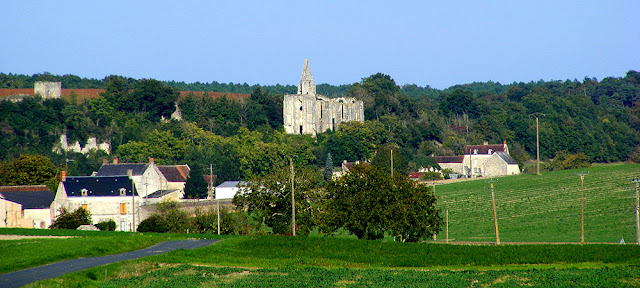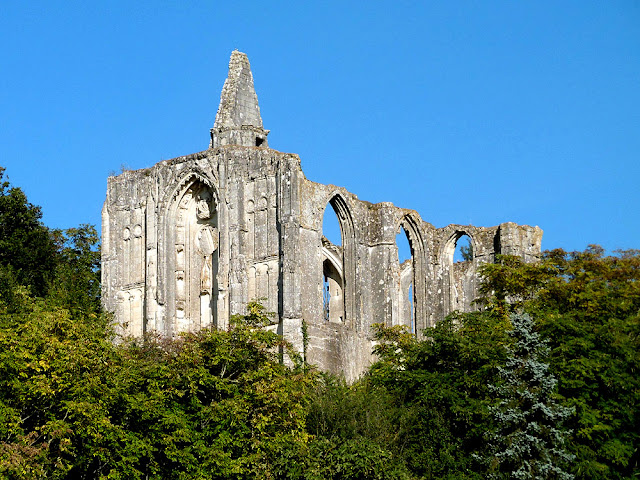Up on a hill near the village of Avons les Rochers sit the ruins of Les Roches Tranchelion -- an imposing church and a medieval castle. The church dates from the 1520s and was consecrated as a funerary chapel and parish church, replacing the castle's private chapel. Despite its ruinous state it retains some very fine carvings and the vaulting is more than 12 metres above the ground. The castle is older, 15th century, and all that remain are the lower parts of a square tower and the southern wall, equipped with murder holes and a network of underground casemates, all of which is being taken over by vegetation.
 |
Seraphim surmounted by scallop shells on the entrance to the ruined church.
|
It was in this castle that Charles VII gathered his Great Council in the summer of 1449 before heading out on the last campaign to kick the English out of France and end the Hundred Years War.
 |
| The ruined castle. |
|
At one time it was the property of the Montgomery family. In 1559 the castle became a temporary refuge for Gabriel de Lorges, Count of Montgomery, Captain of the Scots Guard (the King's bodyguards) after he had inadvertently mortally wounded King Henri II in a joust at the end of June of that year. He spent the July here then fled to England in August.
 |
A high-relief sculpture of God the Father, delivering a benediction with his right hand and holding a globe in his left.
|
Even though it is so damaged, the highly carved western end of the church remains one of the best examples of 16th century religious art in the Touraine, along with the church at Montrésor, the chapel at the Chateau of Ussé, and the chapel at Champigny sur Veude. The church itself is a double aisled nave, with a vaulted transept, vaulted crypt under the choir and semi-octagonal apse. It was more or less abandoned in 1600, only being used sporadically until the Revolution, when it was totally abandoned.
 |
Les Roches Tranchelion.
|
A number of legends are associated with the site, and amazingly, the one about buried treasure turned out to be true. One day in 1966 some young men were working on improving the access to the chapel and they saw right in front of them a large hole opening up. Six or seven metres down they found 214 French and Spanish coins dating from between 1563 and 1618.
 |
Les Roches Tranchelion.
|
The castle was already destroyed by the 17th century, but the church survived until after the Revolution, when it became the victim of ignorance and vandalism.
 |
The western front of the church.
|
 |
The inside of the church is covered in graffiti from several centuries.
|
 |
Looking up at the ruined church.
|
 |
Decorative medallions on the western front of the church, depicting, by the look of it, acanthus foliage, a mercenary soldier and a Greek scolar.
|
 |
Vaulting in the transept of the church.
|
************************************************
For details of our private guided tours of chateaux, gardens, wineries, markets and more please visit the
Loire Valley Time Travel website. We would be delighted to design a tour for you.
We are also on
Instagram, so check us out to see a regularly updated selection of our very best photos.











9 comments:
Do you know if these ruins are maintained in some way?
Thak you for these interesting posts about lesser known landmarks.
hauntingly beautiful
Concrete and steel will never equal stone for truth.
Yes, I assume the municipality is responsible for them. Access is maintained, and I'm sure if they required building work the money would be found -- probably from higher up the admin chain.
The church is considered a rather mystical place by many locals.
Really? Why? I don't know what you mean.
What about the Sagrada Familia Basilica in Barcelona, Spain, built entirely of concrete and reinforced concrete?
It's an interesting conversation. I'm sure other examples of modern construction of religious sites exist. I don't for a moment deny their beauty. My observation has a strongly emotional basis: thst stones may be said to be living things (as Bernini commented about marble) and exude an ancient life from way before humans had evolved. All human emotions seek stone for its enduring impermanence, a kind of trick we want to believe in in the face of the truth that nothing lasts forever. Also, for me anyway, concrete just seems more quick and mass-produced than meditative and of the earth. Your many posts of old villages and churches and bridges and ruins are hugely awesome and quietly profound: thank you!
Glad you are enjoying the photos.
Post a Comment